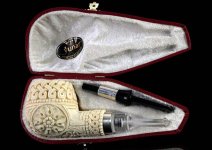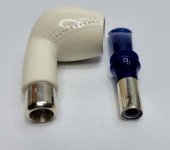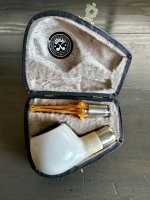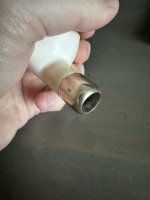I was looking to add a meerschaum to my spigot collection, but as I search through the selections, I find that I start developing more questions than confidence in the spigot fit on these.
I have been disappointed in my Savinelli and Rattray briar spigots, because they turned out to be faux spigots, where the fit is a regular mortice/tenon fitment, with a faux band on the stem side to make it look like a spigot when assembled, without the function of one. I am just keeping these as novelties... :::sigh:::
A true spigot has the fit come from a correct military angle on the cone of the stem side, held by the compression into the same angle of the inverted cone in the mortice in the briar. So, the fit is metal into briar, with a metal band keeping the briar compressed and preventing splitting. On most meerschaum pipes with spigot fits, I never see the stem removed. But, on a couple, I did see where the spigot was faux on one with a regular mortice tenon fit and the faux metal on the stem is decorative, and this one...
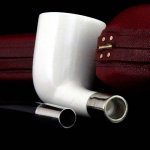
This one shows that the fit is metal on metal? I cannot imagine that this would hold, since metal is prone to bending out of shape, making the tenon eventually loose.
That brought up another question... can a traditional spigot fitment with metal into meerschaum even work? The soft stone would eventually abrade away if careful with inserting, and would break with careless use. Briar works, because it is slightly spongy and will create a compression around the stem, and the matching angles holds it firmly in place, regardless of how careful the stem is inserted over time.
Does anyone own a true spigot meerschaum? What is your take on the longevity of the fit? Should I just exclude meerschaums my spigot collection?
Should I just buy a meerschaum and make a sterling screw in type of fit for a spigot?
I have been disappointed in my Savinelli and Rattray briar spigots, because they turned out to be faux spigots, where the fit is a regular mortice/tenon fitment, with a faux band on the stem side to make it look like a spigot when assembled, without the function of one. I am just keeping these as novelties... :::sigh:::
A true spigot has the fit come from a correct military angle on the cone of the stem side, held by the compression into the same angle of the inverted cone in the mortice in the briar. So, the fit is metal into briar, with a metal band keeping the briar compressed and preventing splitting. On most meerschaum pipes with spigot fits, I never see the stem removed. But, on a couple, I did see where the spigot was faux on one with a regular mortice tenon fit and the faux metal on the stem is decorative, and this one...

This one shows that the fit is metal on metal? I cannot imagine that this would hold, since metal is prone to bending out of shape, making the tenon eventually loose.
That brought up another question... can a traditional spigot fitment with metal into meerschaum even work? The soft stone would eventually abrade away if careful with inserting, and would break with careless use. Briar works, because it is slightly spongy and will create a compression around the stem, and the matching angles holds it firmly in place, regardless of how careful the stem is inserted over time.
Does anyone own a true spigot meerschaum? What is your take on the longevity of the fit? Should I just exclude meerschaums my spigot collection?
Should I just buy a meerschaum and make a sterling screw in type of fit for a spigot?






